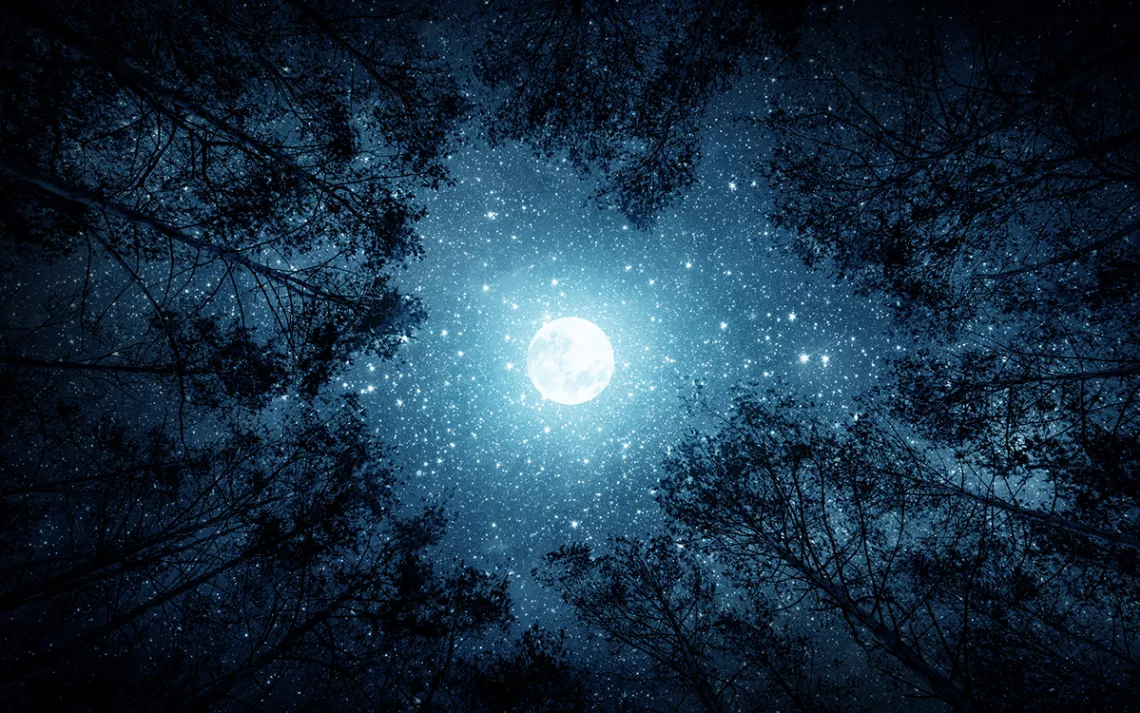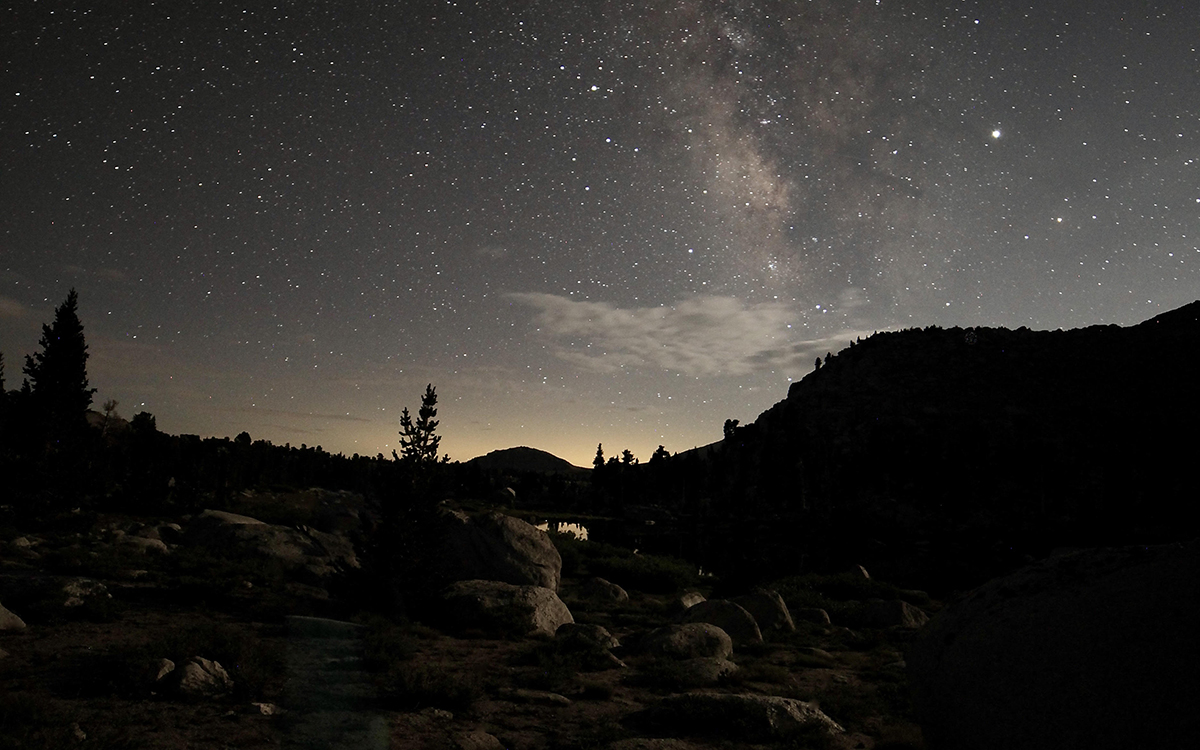July Stargazing: The Pandemic of Night Blindness
Humans can see in the dark quite well—if only we turn away from our artificial lights

Photo by Trifonov_Evgeniy/iStock
The first time I realized I could see in the dark was in 1994. I was just out of high school and my dad and I decided to take one last hiking trip before I packed up and headed off to college.
“Longs Peak,” he said. I felt a surge of excitement. I’d stared at the iconic mountain from our home in the suburbs of Denver since I was a small child, and I had always dreamed of climbing it.
“Longs Peak,” I replied.
My dad obtained the required permits and did the prehike scouring of maps and guidebooks—as he always did. The day before our climb we sifted through our equipment, making sure we had the proper gear. After dinner, dad spread a topographic map out on the kitchen table and traced his finger over the trail. “We leave in six hours,” he said, looking at his watch. It was a little after 6 P.M. “Get to bed now.”
I was puzzled. The sun was shining, and it was only an hour and a half drive to the trailhead. “Won’t we be getting there in the dark?” I asked.
“Yes,” he replied, explaining we’d use the light of a nearly full moon to navigate the trail to Longs’s famed “boulderfield.” “We should get there by sunrise. From there we’ll climb to the Keyhole and up to the summit.”
“But it will be nighttime,” I replied. “We won’t be able to see.”
“We will,” he said with a wry smile. “Trust me.”
We woke at midnight and drove through the night. When we arrived at the trailhead, we tied on our boots and packed our bags by the glow of the interior lights of the Bronco. Beyond was blackness. The prospect of walking for hours at altitude through the night was daunting, even scary. But after only a few minutes on the trail, it quickly became apparent that our eyes, given adequate time to adapt, were perfectly capable of negotiating the rocky terrain in the night. The mountains were rendered in a vivid monochrome, as if the land had been dipped in glowing silver.
Then came a scene I will never forget. We climbed out of a stand of pygmy conifers at timberline and into a vast clearing. We had arrived at the boulderfield—and we’d made it easily. The moon loomed above the great crumbling pyramid of Longs Peak. My eyes, now fully adapted to the dark, could perceive its ragged ridges in fine detail.
From there it was another two hours to the summit. I don’t remember much about the details of the final scramble to the top of Longs, but the vivid scenes of that glorious approach in darkness remain etched in my memory.

Photo by Jeremy Miller
*
We human beings have become creatures of electric light. In doing so, we have mostly forgotten that our eyes are exquisitely adapted to seeing in the dark. Allow me, then, to take you back for a moment to junior high science class. Recall that our eyes are very similar in structure to a camera. The pupil, like the aperture of a lens, opens and closes based on the amount of light that is present. The pupil, in turn, allows light to strike the retina, which is covered in light-sensitive rod and cone cells. Cones detect color and fine detail but need lots of light to function. Rod cells are far more sensitive to low light and are critical to our ability to see at night. These cells function by way of a host of chemical intermediaries, which convert light to electrical signals that the brain interprets and processes into images. The key chemical in this process is a protein, derived from vitamin A, called rhodopsin.
Along with rhodopsin, my hike to the top of Longs all those years ago was made possible by time. When rhodopsin is exposed to light, it breaks down, or “bleaches,” causing our night vision to deteriorate. But after a mere 30 minutes in darkness, rhodopsin will regenerate, and our night vision will return. Which is to say that for most, night blindness is a temporary condition. (Though some people suffer from a congenital form of night blindness, known as nyctalopia, which results from the eye’s inability to synthesize rhodopsin.)
Even the most sensitive of human eyes are no match for the eyes of nature’s most powerful night-seer—the owl. Owl eyes have a concentration of rod cells five times greater than that of the human eye. In addition to their profusion of rods, owls (as well as some other nocturnal vertebrates) also have a specialized structure in their retina called the tapetum lucidum. This sheath-like organ acts as a kind of biological mirror, reflecting light a second time to the retina and further sharpening the image.
Much of our inability to see in the dark has nothing to do with an inherent weakness in our eyes but a willful suppression of the night. Many innovations associated with “progress”—the lightbulb, the streetlamp, the halogen headlight—were designed with the sole purpose of beating back darkness. The reach and impact of this flood of artificial light cannot be overstated. One of the best-known satellite images shows our planet at night, with the tendrils of cities metastasizing into the planet’s vanishing dark spaces.
Our homes and workplaces have experienced a similar creep of stray light. According to a recent study, the average American spends more than 10 hours per day gazing into the electronic abyss. Our inability to escape artificial light is having a tremendous impact on our health. Our circadian rhythms, regulated largely by a hormone called melatonin, are set to cycles of light and darkness. When those cycles are interrupted, a multitude of health problems can arise, including obesity, depression, diabetes, heart disease, and cancer.
Our collective night blindness has come at the expense of our health as well as the well-being of nocturnal animals and ecosystems. It has also caused us to lose our sense of place in the grand sweep of the cosmos. To regain a sense of why darkness matters, I recommend leaving the flashlight behind and taking a long walk in the night. Start nearby, at a local park or some open parcel unburdened by streetlamps. Away from the constant glow of modern life, you’ll find that you can, given enough time, see the night-world quite clearly.
WHAT TO LOOK FOR IN JULY
This month in the Northern Hemisphere, even in areas with extreme light pollution, you should be able to see the summer’s most iconic array of stars, known as the summer triangle. The triangle spans three constellations—Cygnus, the Swan; Aquila, the Eagle; and Lyra, the Harp—and includes three of the brightest stars in the summer sky—Vega, Deneb, and Altair. While this star pattern is known even to novice astronomers, its grouping as a star pattern, or asterism, seems to be a relatively recent notion. Some sources have attributed it to the cartoonist H.A. Rey, best known for his character Curious George. In the mid-1950s, Rey wrote a well-known children’s guide to astronomy called Find the Constellations, in which he refers to the three-star assemblage as the “summer triangle.”
Around July 12, the Delta Aquariids meteor shower begins. Though this is one of the more obscure meteor showers of the year—overshadowed by the stunning Perseids meteor shower, which commences in mid-August—the Delta Aquariids can put on a good show, particularly from dark locations on lower latitudes. On a clear night with little moon glow, viewers can expect to see between 10 and 20 meteors per hour. To find the center of the meteor activity, find the Great Square of the constellation Pegasus and trace a line toward the horizon to the dim constellation of Aquarius. The meteors will appear to radiate from a point near the bright star Fomalhaut, which, for viewers in northern latitudes, never strays far above the horizon.
Moon-gazers should mark July 23 on their calendar. That is the date that the full moon, also called the Buck Moon, will rise overhead. The moon, according to the Old Farmers’ Almanac, was so named by Indigenous peoples of the Americas because this is the time of year when the antlers of male deer begin to emerge.
 The Magazine of The Sierra Club
The Magazine of The Sierra Club







